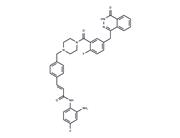| Name | Milciclib |
| Description | Milciclib (PHA-848125) (PHA-848125) is a potent, ATP-competitive CDK inhibitor for CDK2 with IC50 of 45 nM. It is >3-fold more selective for CDK2 than CDK1, 2, 4, 5, and 7. Phase 2. |
| Cell Research | Melanoma cells are suspended in culture media at a concentration of 2 × 104 cells/mL, dispensed in 50 μL aliquots into flat-bottom 96-well plates and allowed to adhere overnight at 37 °C. Graded amounts of PHA-848125 or TMZ are then added to the wells (4 wells per point) in 50 μL of CM and the plates are incubated at 37 °C in a 5% CO2 humidified atmosphere for 5 days. The cytotoxic effects of TMZ are also evaluated in combination with the MGMT inhibitor BG. To this end, 10 μM BG is added to the plates 2 hours before TMZ and left in culture for the entire period of cell exposure to the drug. ContS1017rol groups are represented by untreated cells and cells treated with BG or DMSO alone. The growth of the cells treated with BG or DMSO alone does not differ from that of untreated cells. MGMT activity of BG-treated cells is undetectable 2 hours after the addition of the inhibitor PHA-848125 and remained essentially undetectable up to the end of the assay. Normal melanocytes are suspended in MGM at the concentration of 1.6 × 105 cells/mL, plated (50 μL/well) and exposed to TMZ + BG or to PHA-848125 as described for melanoma cells. At the end of the incubation period, cell growth is evaluated by the MTT assay. Briefly, 0.1 mg of MTT (in 20 μL of PBS) is added to each well and cells are incubated at 37 °C for 4 hours. Cells are then lysed with a buffer (0.1 mL/well) containing 20% SDS and 50% N,N-dimethylformamide, pH 4.7. After overnight incubation, the absorbance is read at 595 nm using a 3550-UV microplate reader. Cell sensitivity to drug treatment is expressed in terms of IC50 (drug concentration producing 50% inhibition of cell growth, calculated on the regression line in which absorbance values at 595 nm are plotted against the logarithm of drug concentration).(Only for Reference) |
| Kinase Assay | Biochemical kinase inhibition assays: Inhibition of kinase activity by PHA-848125 is assessed using a strong anion exchanger (Dowex 1X8 resin)–based assay in robotized format run on 384-well plates. In this assay, specific peptides or protein substrates are transphosphorylated by their specific kinase in the presence of ATP traced with [γ-33P]ATP using optimal buffers and cofactors. The potency of PHA-848125 toward CDKs and 38 additional kinases belonging to an in-house Kinase Selectivity Screening panel is evaluated, and the relevant IC50s are determined. For each enzyme, the absolute KM values for ATP and the specific substrate are calculated and each assay is then run at optimized ATP (2KM) and substrate (5KM) concentrations. This setting enables direct comparison of IC50 values of PHA-848125 across the panel for evaluation of its biochemical profile. |
| In vitro | Milciclib inhibits, although with lower potency, the activities of cyclin H/CDK7, cyclin D1/CDK4, p35/CDK5, as well as cyclin E/CDK2 and cyclin B/CDK1 with IC50 values of 0.15, 0.16, 0.265, 0.363, 0.398 μM, respectively. [1] Thropomyosin receptor kinase A is also inhibited by Milciclib in the same nanomolar range as CDKs. In the most Milciclib-sensitive cell line, Milciclib induces a concentration-dependent G(1) arrest.[2] Milciclib also impairs phosphorylation of the retinoblastoma protein at CDK2 and CDK4 specific sites, reduces retinoblastoma protein and cyclin A levels, and increases p21(Cip1), p27(Kip1) and p53 expression. Milciclib is added to the cells 48 h after TMZ and cell growth is evaluated after 3 additional days of culture. [2] A drug combination of TMZ, BG and Milciclib induces an additive or synergistic effect on cell growth, depending on the cell line. [2] In the absence of BG, the combination is still more active than the single agents in cell lines moderately sensitive to TMZ, but comparable to Milciclib alone in the two TMZ-resistant cell lines. When TMZ plus BG are used in combination with Milciclib against cultured normal melanocytes, neither synergistic nor additive antiproliferative effects are observed.[2] |
| In vivo | In the preclinical xenograft A2780 human ovarian carcinoma model, Milciclib reveals good efficacy and is well tolerated upon repeated daily treatments. Treatment of K-Ras(G12D)LA2 mice with Milciclib (40 mg/kg twice daily for 10 days) results in significant tumor growth inhibition at the end of the treatment and is accompanied by a reduction in the cell membrane turnover.[3] On the other hand, following oral administration, Milciclib shows significant antitumor activity in various human xenografts, carcinogen-induced tumors and in disseminated primary leukemia models; the plasma concentrations in rodents being in the same range as those found inhibiting cancer cell proliferation.[4] |
| Storage | Powder: -20°C for 3 years | In solvent: -80°C for 1 year | Shipping with blue ice/Shipping at ambient temperature. |
| Solubility Information | H2O : < 1 mg/mL (insoluble or slightly soluble)
Ethanol : < 1 mg/mL (insoluble or slightly soluble)
10% DMSO+40% PEG300+5% Tween 80+45% Saline : 3.3 mg/mL (7.17 mM), Sonication is recommended.
DMSO : 85 mg/mL (184.55 mM), Sonication is recommended.
|
| Keywords | Trkreceptor | TrkA | Trk receptor | PHA848125 | PHA 848125 | Milciclib | Inhibitor | inhibit | Cyclin dependent kinase | CDK7/CyclinH | CDK5/p35 | CDK4/CyclinD1 | CDK2/CyclinA | CDK | Autophagy |
| Inhibitors Related | Stavudine | Xylitol | Aceglutamide | Sodium 4-phenylbutyrate | Hydroxychloroquine | Guanidine hydrochloride | Taurine | Valproic Acid | Curcumin | Paeonol | Naringin | Gefitinib |
| Related Compound Libraries | Failed Clinical Trials Compound Library | Bioactive Compound Library | Membrane Protein-targeted Compound Library | Kinase Inhibitor Library | Tyrosine Kinase Inhibitor Library | Anti-Cancer Clinical Compound Library | Drug Repurposing Compound Library | Inhibitor Library | Anti-Aging Compound Library | Bioactive Compounds Library Max | Anti-Cancer Active Compound Library | Anti-Cancer Drug Library |

 United States
United States






